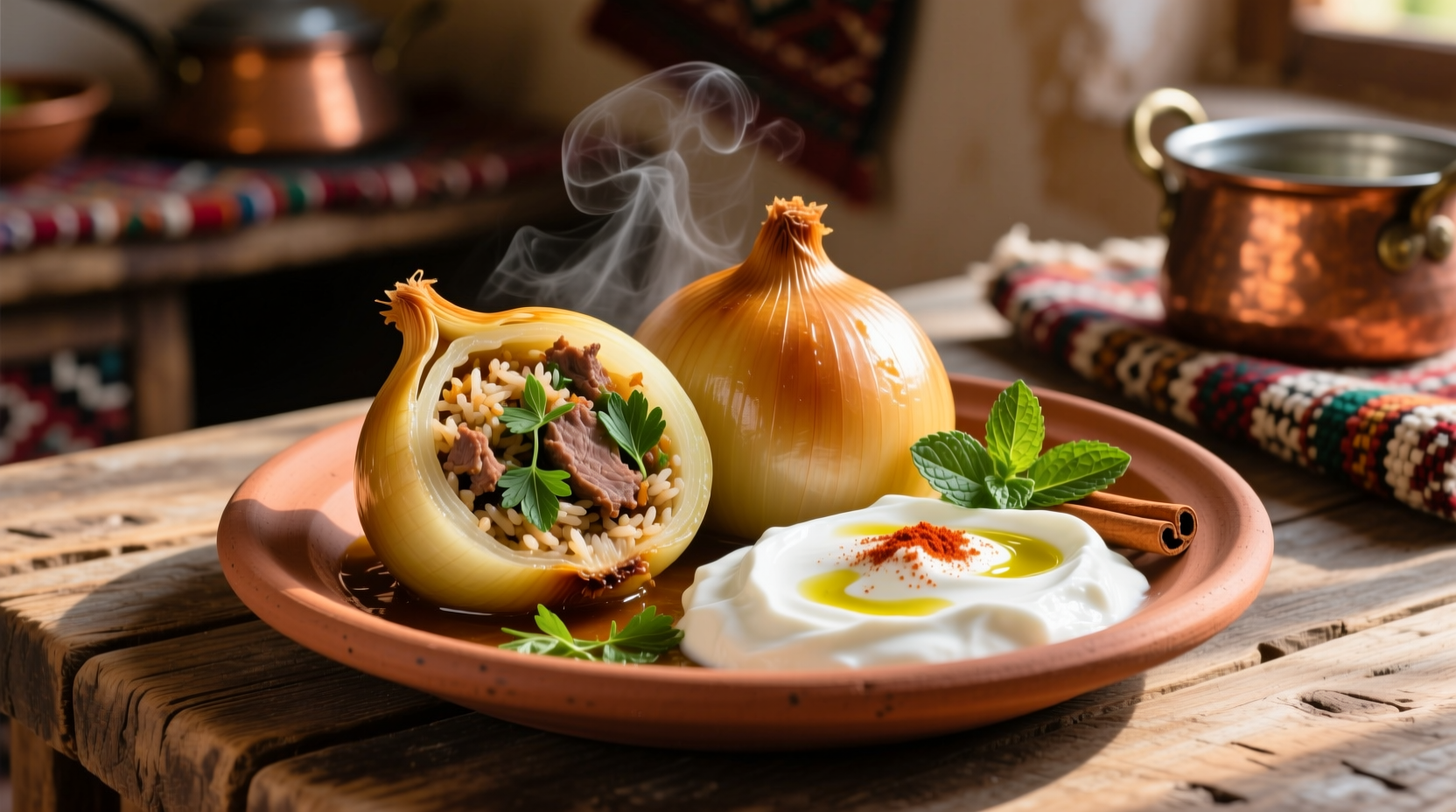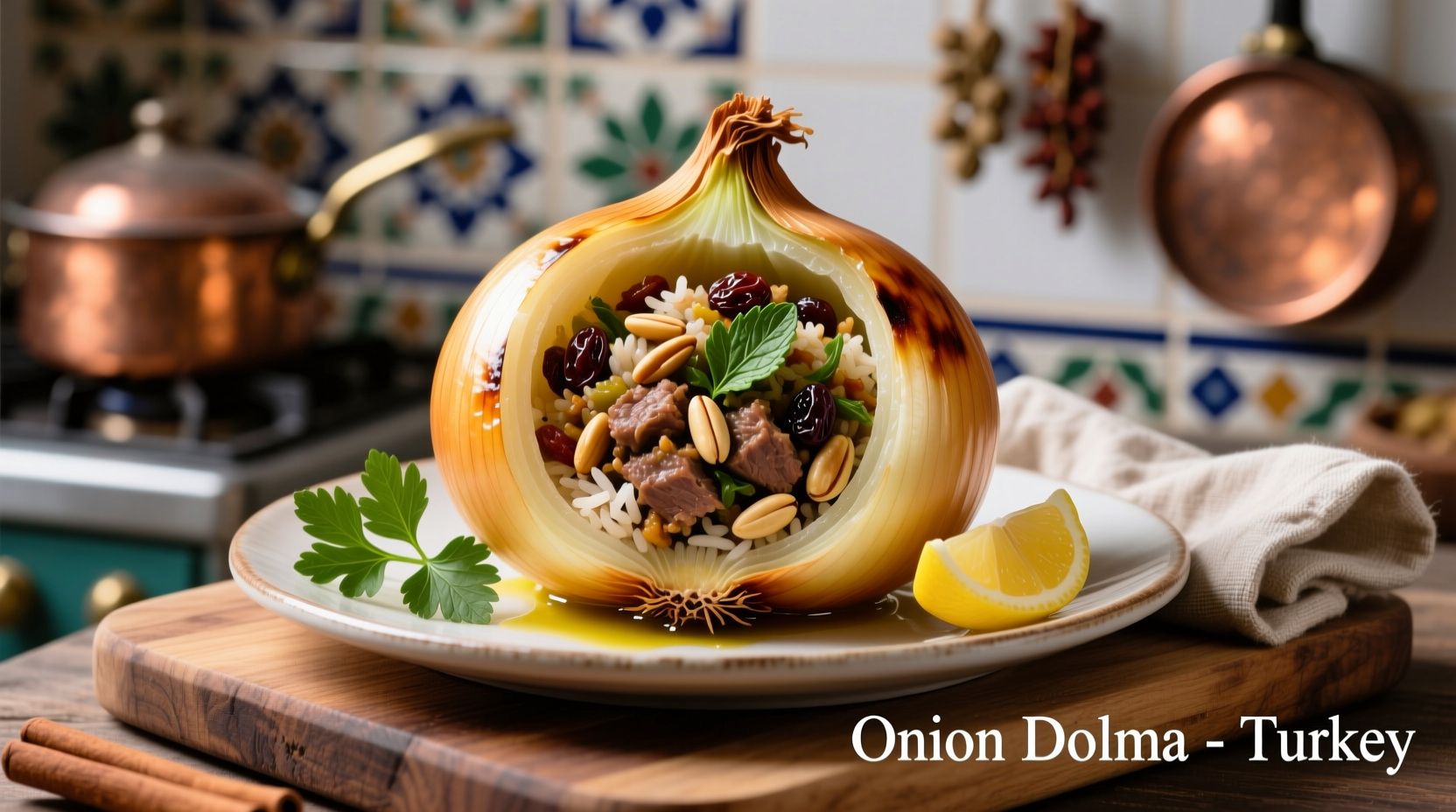Onion dolma is a traditional Middle Eastern and Turkish dish featuring hollowed onions stuffed with a savory mixture of rice, herbs, and spices, then simmered in broth until tender. This centuries-old recipe creates tender onions with flavorful filling that absorbs aromatic broth, perfect as a main course or side dish.
Have you ever wondered how to transform humble onions into an elegant, flavorful centerpiece for your dinner table? Onion dolma—the art of stuffing onions with aromatic rice and meat mixtures—has graced Middle Eastern and Mediterranean tables for centuries. This authentic preparation method yields tender, flavorful onions that absorb the rich broth they're cooked in, creating a dish that's simultaneously comforting and sophisticated.
The Cultural Roots of Onion Dolma
Onion dolma traces its origins to the Ottoman Empire, where resourceful cooks transformed simple ingredients into culinary masterpieces. The word "dolma" comes from the Turkish verb "doldurmak," meaning "to fill" or "to stuff." While grape leaves are the most famous dolma vessel, onions provide a uniquely sweet and tender alternative that's particularly popular in Turkish, Armenian, and Greek culinary traditions.
| Region | Distinctive Features | Common Ingredients |
|---|---|---|
| Turkish | Served with yogurt, often includes meat | Lamb, allspice, mint, tomato broth |
| Armenian | Sweeter profile, often vegetarian | Rice, currants, cinnamon, pomegranate molasses |
| Greek | Lemon-infused broth, lighter seasoning | Rice, dill, parsley, lemon juice |
Essential Ingredients for Authentic Onion Dolma
The magic of onion dolma lies in its balance of sweet onion, savory filling, and aromatic broth. Here's what you'll need for the perfect traditional preparation:
For the Onions:
- 6-8 large yellow onions (about 3 inches in diameter)
- Water for blanching
For the Filling:
- 1 cup long-grain rice (rinsed)
- ½ pound ground lamb or beef (optional for vegetarian version)
- ¼ cup pine nuts or slivered almonds
- ¼ cup currants or raisins
- 1 small onion, finely chopped
- 2 tablespoons fresh mint, chopped
- 2 tablespoons fresh dill, chopped
- 1 teaspoon allspice
- ½ teaspoon cinnamon
- Salt and pepper to taste
For the Broth:
- 4 cups meat or vegetable broth
- 1 large tomato, grated
- 2 tablespoons tomato paste
- 2 tablespoons lemon juice
- 2 tablespoons olive oil

Step-by-Step Preparation Guide
Creating perfect onion dolma requires patience and attention to detail. Follow these professional techniques for authentic results every time.
Preparing the Onions
Start by trimming the root end of each onion while keeping the base intact. Carefully peel the outer layer, then make a small incision around the top. Blanch in boiling water for 3-4 minutes until the layers begin to separate. Using a small spoon or knife, gently hollow out the center while preserving a ¼-inch thick shell. Set aside the removed onion layers for the broth.
Creating the Perfect Filling
In a skillet over medium heat, sauté the ground meat (if using) until browned. Add the chopped onion and cook until translucent. Remove from heat and mix with rice, herbs, spices, pine nuts, and currants. The filling should be moist but not wet—add a tablespoon of broth if too dry. Fill each onion shell three-quarters full, pressing gently to ensure the filling holds its shape during cooking.
Cooking Techniques for Optimal Results
Arrange the stuffed onions in a single layer in a heavy-bottomed pot. Combine the broth ingredients with the reserved onion pieces and pour over the dolma. Place a heatproof plate on top to prevent the onions from moving during cooking. Simmer covered over low heat for 45-60 minutes until the onions are tender but still holding their shape and the rice is fully cooked.
Avoiding Common Onion Dolma Mistakes
Even experienced cooks encounter challenges with this delicate dish. Here's how to avoid the most frequent pitfalls:
- Onions falling apart: Don't over-blanch—3-4 minutes is sufficient. Use a sharp knife to carefully separate layers without tearing.
- Dry filling: Ensure your rice-to-liquid ratio is correct (1:1.5). The broth should fully absorb during cooking.
- Bitter taste: Use fresh allspice and cinnamon—stale spices can turn bitter when cooked.
- Soggy onions: Don't overcrowd the pot. Each onion needs space for even cooking.
Serving Suggestions and Variations
Traditional Turkish onion dolma reaches its full potential when served with complementary elements that enhance its complex flavors. The ideal presentation includes:
- A generous dollop of cool, plain yogurt to balance the dish's richness
- Fresh lemon wedges for a bright acidic note
- Chopped fresh parsley or dill as garnish
- A side of crusty bread to soak up the flavorful broth
For vegetarians, simply omit the meat and use vegetable broth. Some regional variations include adding a tablespoon of pomegranate molasses to the broth for a subtle sweet-tart complexity that's particularly popular in Armenian preparations.
Storage and Reheating Tips
One of onion dolma's beautiful qualities is that it often tastes even better the next day as the flavors continue to meld. Store leftovers in an airtight container in the refrigerator for up to 4 days. When reheating, add a splash of broth or water to restore moisture, and warm gently over low heat to prevent the onions from breaking apart. Avoid microwaving, which can make the onions rubbery.
When to Serve Onion Dolma: Cultural Context
Understanding the appropriate context for serving onion dolma enhances your appreciation of this traditional dish. In Turkish culture, dolma dishes are often prepared for special occasions and family gatherings. They're particularly common during spring celebrations when fresh herbs are abundant. While acceptable as an everyday meal, onion dolma carries connotations of hospitality and care—each stuffed onion represents the time and attention the cook has invested.
Unlike grape leaf dolma, which is often served cold as a meze (appetizer), onion dolma is traditionally served warm as a main course or substantial side dish. It's inappropriate to serve this dish at funerals or other solemn occasions in many Middle Eastern cultures, as stuffed foods symbolize abundance and celebration.
Historical Evolution of Onion Dolma
The journey of onion dolma reflects centuries of culinary exchange across continents:
- 15th-16th century: Ottoman palace kitchens develop sophisticated stuffing techniques using available vegetables
- 17th century: Trade routes introduce New World ingredients like tomatoes, incorporated into broth
- 19th century: Recipe collections document regional variations across the empire
- Early 20th century: Migration spreads dolma traditions to Europe and Americas
- Present day: Modern interpretations balance tradition with contemporary dietary preferences
According to food historians at the University of Istanbul's Culinary Heritage Project, onion dolma became particularly popular during Ramadan as a substantial dish that could be prepared in advance and gently reheated for iftar meals. The slow-cooking method allowed flavors to develop while requiring minimal attention during busy preparation periods.











 浙公网安备
33010002000092号
浙公网安备
33010002000092号 浙B2-20120091-4
浙B2-20120091-4